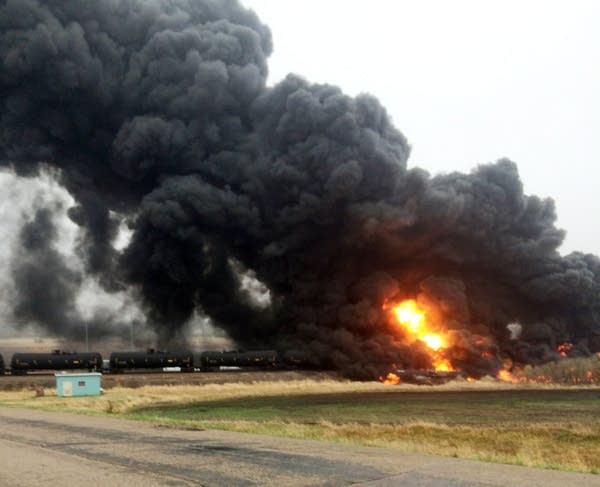Evacuated residents allowed home after ND oil train derailment

Go Deeper.
Create an account or log in to save stories.
Like this?
Thanks for liking this story! We have added it to a list of your favorite stories.
Updated: 9:40 a.m. | Posted: 7:36 a.m.
An oil train that burst into flames after derailing in North Dakota was extinguished early Thursday, and nearby residents who were evacuated from their homes were allowed to return. Crews were removing the remaining oil from the tank cars that burned.
The 20 people who live in Heimdal went home Wednesday night after the fire died down, Wells County Commission Chairman Mark Schmitz said.
Turn Up Your Support
MPR News helps you turn down the noise and build shared understanding. Turn up your support for this public resource and keep trusted journalism accessible to all.
"It had pretty much quieted down by 8, 9 o'clock," he said of the fire scene. "Firemen said it was just a matter of watching it, making sure it didn't flare up again."
Residents were ordered from their homes shortly after the BNSF Railway train derailed about 7:30 a.m. Wednesday outside the town, about 115 miles northeast of Bismarck. No injuries were reported.
The National Transportation Safety Board is investigating the cause of the wreck.
The six cars that caught fire on the 109-car train were carrying approximately 180,000 gallons of oil, according to BNSF vice president Mike Trevino. He did not immediately know early Thursday how much burned and how much was left in the cars once the fire was extinguished but he expected the operation to transfer the oil to trucks to wrap up by midday.
Once the NTSB has cleared the site, the derailed cars can be removed, and this should happen by Thursday evening, Trevino said.
Officials are trying to determine how much oil spilled onto the ground and to get it cleaned up, Trevino said.
The rail line through Heimdal runs next to an intermittent waterway known as the Big Slough, which drains into the James River about 15 miles downstream. Some oil got into the slough, but it was contained and was being recovered, state Emergency Services spokeswoman Cecily Fong said early Thursday.
The train was hauling crude from the state's oil patch, and the accident raised questions about whether new state standards intended to reduce the volatility of such shipments are sufficient.
Industry representatives and state officials said oil companies have been complying with a standard that went into effect April 1 requiring them to remove propane, butane and other gases that occur in North Dakota crude to reduce the chance of tank cars catching fire. There was no immediate indication of a violation of that rule with the train involved in Wednesday's accident.
The six tank cars that exploded into flames were a model slated to be phased out or retrofitted by 2020 under a federal rule announced last week. It's the fifth fiery accident since February involving that type of tank car, and industry critics responded to the latest with calls for them to be taken off the tracks immediately to prevent further fires.
For residents of Wells County — which oil trains cross daily — the disaster was the realization of something they always feared might happen, Schmitz said.
"It's definitely been in the back of everybody's minds," he said.


